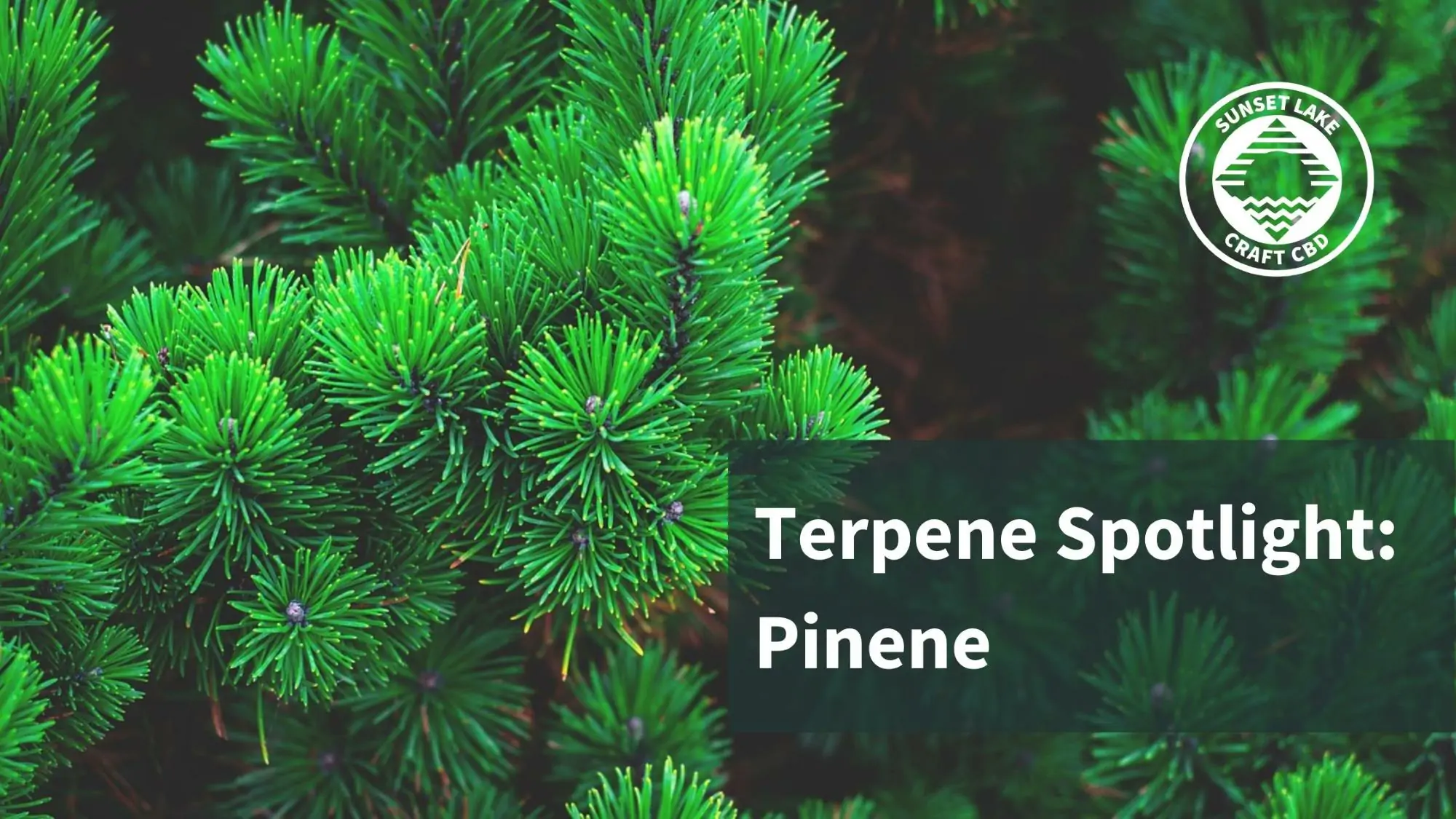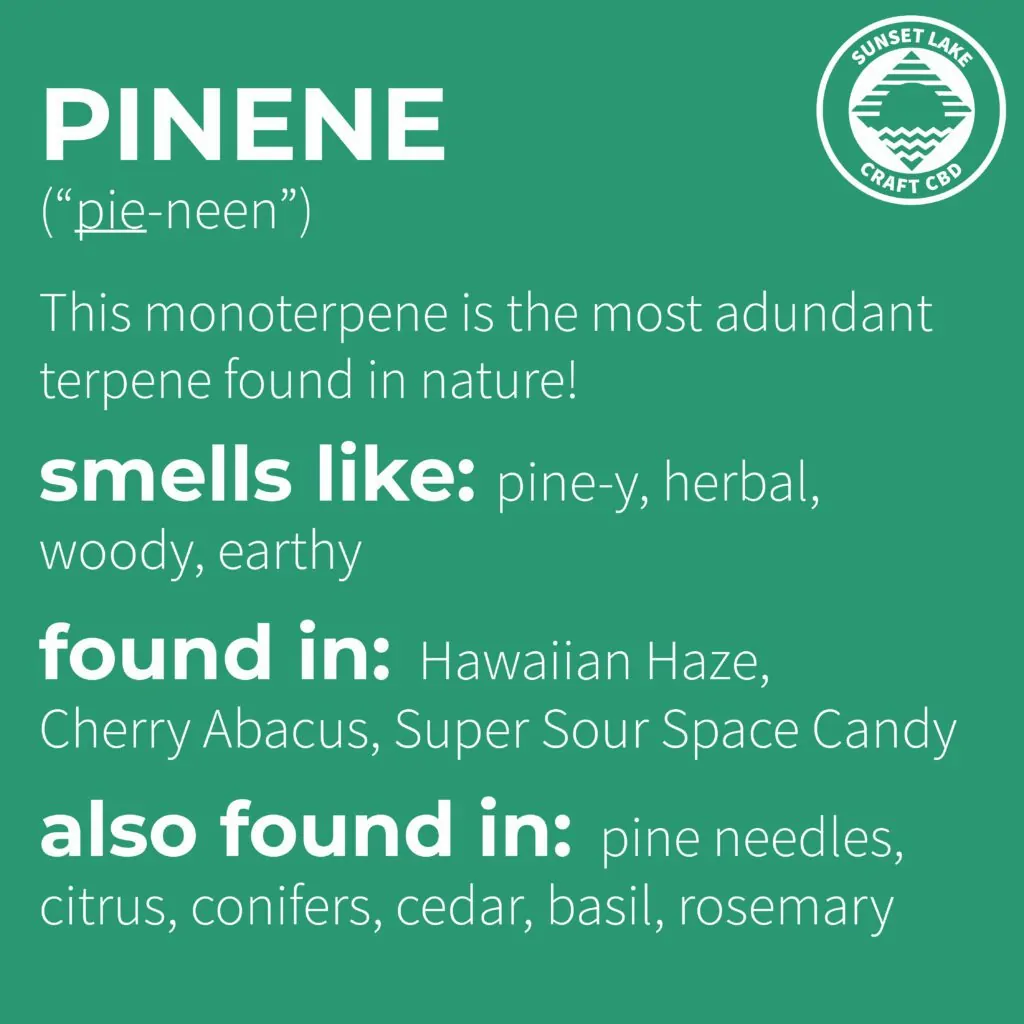No products in the cart.
Terpene Spotlight: Pinene

Humans have coexisted with hemp for millennia. We are only now beginning to understand all of its chemical constituents. Besides producing more than 100 cannabinoids, hemp also produces between 300-400 terpenes. Pinene [pie-neen] is the most common terpene found in nature and is one of the most commonly found terpenes in hemp flower. Besides adding a pleasant aroma to soaps and cosmetics, pinene is being researched for its potential therapeutic applications.1
In this post, we’ll discuss:
- What Pinene is
- Where pinene can be found in nature
- And, what applications for pinene are being investigated by researchers
What Are Terpenes?
Terpenes are volatile aromatic hydrocarbon compounds composed of isoprene units. The number of isoprene units determines the class of terpene: monoterpenes have two isoprenes; sesquiterpenes have three; and diterpenes have four isoprenes. There are other types of terpenes, but these are the most common classes as it relates to hemp.
Terpenes typically comprise about 1-2% of the weight of a hemp flower. This may seem like a low number compared to CBD contents of 13-17%, but terpenes are powerful and a little goes a long way.
Terpenes are produced by a wide variety of plants and even some animals. It is believed that plants produce terpenes as a way of attracting beneficial insects and warding off threats. Because terpenes are highly volatile, they contribute a great deal to the aroma of most plants, and even some fungi!
Fun fact: If you’re wondering about which animals produce terpenes, you need not look any further than your own skin! Humans produce squalene as a component of sebum.
Here are some other Terpenes that you have likely encountered:
- All citrus fruits contain limonene.
- Woody spices, like cinnamon and black pepper, contain beta-caryophyllene.
- Lavender and hops contain linalool.
What Is Pinene?
More accurately, the question should be what are pinenes? There are two pinenes found in nature: alpha-pinene (α) and beta-pinene (β). Both are monoterpenes and liquid at room temperature. α-pinene is oil- and ethanol-soluble, but not water-soluble. β-pinene is only oil-soluble.2 These two isomers are found in different botanical sources, though they often appear together.
α-Pinene is abundant in pine needles, cedar, dill, basil, parsley, eucalyptus trees, orange rinds, rosemary, conifers, and hemp. β-Pinene is also found in pine and conifer trees, as well as in hemp, hops, camphorweed, cumin, big sagebrush, and a primary component of turpentine. Pinene has a woody, herbal, piney aroma.
According to Ganjier, a cannabis sommelier certification program, Pinene is the dominant terpene in about 7% of all cannabis cultivars.
What Is Pinene Used For?
You will commonly find Pinene as a flavor and fragrance additive in foods, soaps, cosmetics, and insect repellents.4
Historical medical texts indicate that α-pinene may reduce the unwanted intoxicating effects of THC. Modern researchers are investigating this claim.1 Pine nuts and pistachios were commonly prescribed as an antidote to cannabis intoxication.4
In Japan, there is a practice called shinrin-yoku, or “forest bathing,” which may rely partly on pinene emitted by pine trees. The idea of forest bathing is not a new one, but in recent years has garnered attention from researchers. Walking in a forest for relaxation may lead to beneficial health effects. Researchers have shown that inhaling the volatile aromatic compounds emitted by pine trees, including pinene, can open up airways (bronchodilation) and lead to a sense of calm.5
Although pinene has been used for centuries in folk medicine and aromatherapy, scientific research is still needed to confirm (or debunk) these uses.
Research suggests that pinene may have the following potential benefits:
α-Pinene
- antimicrobial 1,2
- antibiotic 6
- improve memory 1,3,4
- acne 1
- bronchodilator 1,3,4
- anti-inflammatory 2,3,4,6
- anti-anxiety 6
β-Pinene
- antimicrobial 1,2
- antibiotic 6
- improve memory 1
- acne 1
- bronchodilator 1
- anti-inflammatory 2
Sunset Lake CBD Cultivars Featuring Pinene
Sunset Lake CBD grows hemp outdoors, under the sun which encourages our hemp plants to produce higher concentrations of a wider variety of terpenes compared to hemp grown indoors. We carefully cure our hemp flower to retain as many terpenes as possible and work with third-party laboratories to understand and measure each cultivar’s terpene content. At first look, these numbers may appear small, but terpenes are potent.
Hawaiian Haze – 0.39% α-Pinene & 0.18% β-Pinene
Cherry Abacus – 0.44% α & 0.13% β
Super Sour Space Candy – 0.24% α & 0.14% β
Candy Kush – 0.21% α- & 0.13% β-
Suver Haze – 0.09% α- & 0.05% β-
Lifter – 0.09% α- & 0.05% β-
Sour Suver Haze – 0.06% α- & 0.1% β-
Sour Lifter – 0.04% α- & 0.07% β-
*Note: the percentage of terpenes is reported on a by-weight basis.
Sources:
- Ahmad, Samoon, and Kevin P. Hill. “Constituents of Cannabis.” Medical Marijuana: A Clinical Handbook, Wolters Kluwer, Philadelphia, 2021, pp.113, 277.
- Salehi, B., Upadhyay, S., Erdogan Orhan, I., Kumar Jugran, A., L D Jayaweera, S., A Dias, D., Sharopov, F., Taheri, Y., Martins, N., Baghalpour, N., Cho, W. C., & Sharifi-Rad, J. (2019). Therapeutic Potential of α- and β-Pinene: A Miracle Gift of Nature. Biomolecules, 9(11), 738. https://doi.org/10.3390/biom9110738
- McPartland, J. M. & Russo, E. B. (2016). Non-Phytocannabinoid Constituents of Cannabis and Herbal Synergy. In Roger G. Pertwee (Ed.), Handbook of Cannabis (p. 287). Oxford University Press.
- Russo E. B. (2011). Taming THC: potential cannabis synergy and phytocannabinoid-terpenoid entourage effects. British Journal of Pharmacology, 163(7), 1344–1364. https://doi.org/10.1111/j.1476-5381.2011.01238.x
- Li Q. (2010). Effect of forest bathing trips on human immune function. Environmental health and preventive medicine, 15(1), 9–17. https://doi.org/10.1007/s12199-008-0068-3
- Ahmad, S. & Hill, K. P. (2021) “The Pharmacodynamics of Cannabis.” Medical Marijuana: A Clinical Handbook, Wolters Kluwer, Philadelphia, pp. 264-286.

